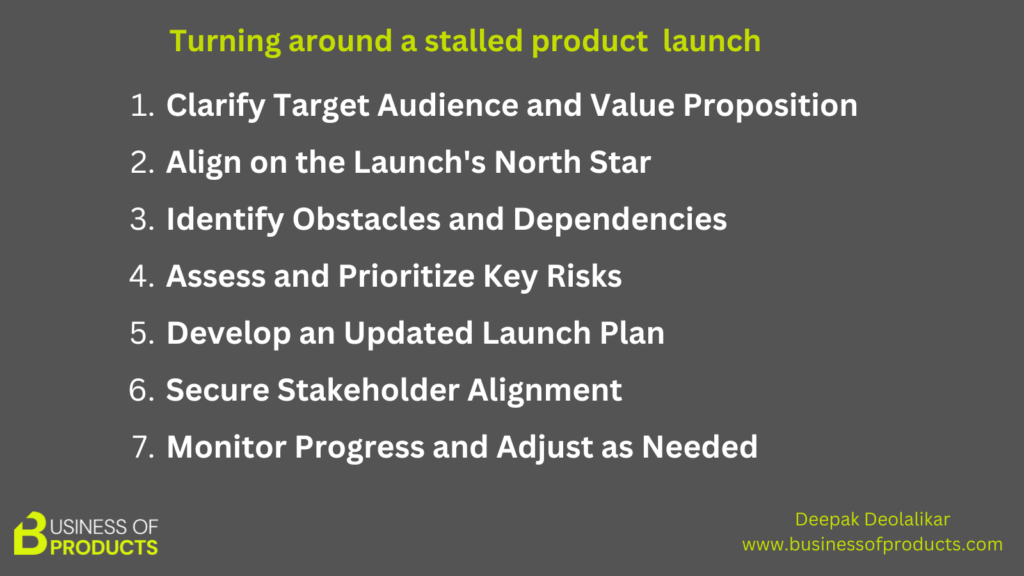How to get your product launch back on track
![]() Your product launch is not going anywhere.
Your product launch is not going anywhere.
Your team is busy cranking out code. But you cannot claim it as a success just yet. No one has a clear idea when the product will be ready. There are weekly status reports but management and stakeholders are confused and cannot make a determination on the real status.
Sounds familiar?
I was once handed a product that was stalling and not going anywhere. There was an expectation to launch in the next 6 months or so. The team had been working on it for some time but no real progress to show. I took over as the PM and was able to turn it around and launched it with fanfare.
Here is a picture of me standing proudly at the company all hands celebration of the launch with the CEO announcing the new product launch as a success. This was 2017 and the product is still being sold and used.
![]()
![]()
![]()

What do you do if your product development is stalled?
I will not go into the reasons for why the product I inherited was stalling. All I knew was that the team was super smart. But I’ll explain how I turned it around.
But before that, why do products fail to launch?
There is a long answer and probably requires a separate post.
But in general :
- There is no clear product strategy or alignment about the product. As a result, any work is justifiable.
- Related to the above, but the scope for the launch has not been outlined or agreed upon. Anything the team comes up with get prioritized.
- The product plan was never formulated e.g launch plan, pricing, positioning, target segment
- Dependencies are not getting resolved and things keep coming and derail progress.
- The original estimates for the product were incorrect and more time is added
- Like any project, there are unplanned risks that potentially could have been identified early on.
There can be many other reasons.
So how you do fix this situation as a product manager?
These are the steps I recommend for anyone who is trying to get their product launch back on track.
- Clarify Target Audience and Value Proposition
- Align on the Products North Star
- Identify Obstacles and Dependencies
- Assess and Prioritize Key Risks
- Develop an Updated Launch Plan
- Secure Stakeholder Alignment
- Monitor Progress and Adjust as Needed

Let’s deep dive.
The first thing I did was to sit down with the engineering team and checked the status of the product as it stands. Turns out the basic JIRA board was incomplete. So I proceeded to build the right processes first so that the team could make the necessary progress while I was getting things back on track.
One option I had was to completely stop the team until we figure out a plan. But in real life, that is a bit impractical. So I asked the team continue. But rather than have them work on features which I was not sure were needed, I asked them to focus on some backend platform stuff. And this was an add on product, so it had to work in the confines of the mothership platform. So I gave the team about 2 sprints worth of work to do. And I went to do my PM tasks.
- Clarify Target Audience and Value Proposition
By the time I joined, there was a basic MVP version. What I was not sure of if there was actual demand for the product. So I decided to run an Alpha test. I solicited about 15 customers from the sales team. I gave them a criteria for the types of customers I want. For example, I wanted happy customers who had been a customer for over 2 years and whom I thought would benefit from the product. The ICP so to speak.
I gave a demo and and installed the alpha version for some. The response was warm. 6 of the 15 wanted the product and 4 others were warm to the idea but wanted other capabilities added.
This was good enough evidence. In my heart I knew this product would not benefit everyone but I wanted the evidence.
Armed with this evidence, I had a clear idea on what Version 1 should look like and what the GTM positioning should be.
Ensure who the target segment for the product is and if the value proposition is aligned to them.
2. Locate the North Star
Sometimes a product stalls because the team loses sight of its main goal, or “North Star.” This goal should focus on the main value the product provides to customers. Focus the scope on the most important thing. Defer everything else.
Bringing the team together to realign on this goal helps everyone focus on what matters. It becomes easier to make decisions and prioritize tasks when everyone knows what success looks like and is working towards the same objective.
It’s a visualization process. Just imagine all the things that need to go right and the product launch is successful. Visualizing the North Star helps identify the path ahead.
3. Identify any roadblocks and dependencies
A launch can get stuck when there are hidden obstacles or things that rely on other tasks or teams. Meet with your team to discuss what’s causing delays, like technical issues, not enough resources, or coordination problems. Map out these challenges, from issues in development to things that depend on outside teams. Understanding the root causes helps you focus on fixing the most critical problems first.
For example, in one case I had to work with finance to get new product SKUs in place so that we can recognize revenue. This sounds trivial but this was the first new SKU for the company in years. Many downstream finance process, workflows, reports needed to be changed. Not to mention approval processes in the CRM.
In another case, we had to change the legal terms and privacy policies. Legal teams needed to consult with outside counsel. All these needs lead times.
4. Identify any known risks and isolate the riskiest
Launching a product always comes with risks, but it’s important to figure out which ones could cause the most trouble. Make a list of what could go wrong, like adding too many features, not having a ready market, or legal concerns. Focus on the biggest risks—the ones that could really disrupt the launch.
Create backup plans or consider scaling back certain features to manage these risks and keep things moving forward.
5. Build an updated launch plan
Once you have a clear vision and know the risks, create a new timeline for delivery. This plan should include deadlines, milestones, and specific roles for each team member. It needs to be realistic but should still push the team to stay focused. Break the plan into smaller goals to keep up momentum. Make sure everyone understands the plan so that they know exactly what needs to be done and by when.
6. Get buy-in from all stakeholders
To get things moving again, you’ll need support from stakeholders. Share the updated plan, the main goal, and what you’re doing to manage risks with key people, like executives, marketing, and sales. Show them how the new plan addresses any past concerns and sets the team up for success. Their backing can help secure extra resources and ensure everyone is working together toward the same goal.
7. Monitor progress and course correct
Even with a solid plan, it’s important to keep an eye on progress and adjust as needed. Hold weekly check-ins with the team and track how you’re doing against your goals. Watch out for data that shows how customers are responding or how well the product is performing. Use this information to spot and fix issues quickly. Being able to adapt on the go will help you avoid further delays and get the product to launch successfully.
Conclusion
Turning around a stalled product launch is challenging but possible with a clear and methodical approach. It starts with validating the need and value for the product, ensuring the team is aligned around a shared vision, and addressing roadblocks and risks head-on.
Building a realistic launch plan and securing stakeholder support are all critical steps in regaining momentum. While setbacks can be frustrating, they’re also opportunities to refine your product and strategy. By following these steps, you can transform from delay to timely delivery, setting your product up for a successful launch.
And if successful, you can templatize the process for all future product launches.

